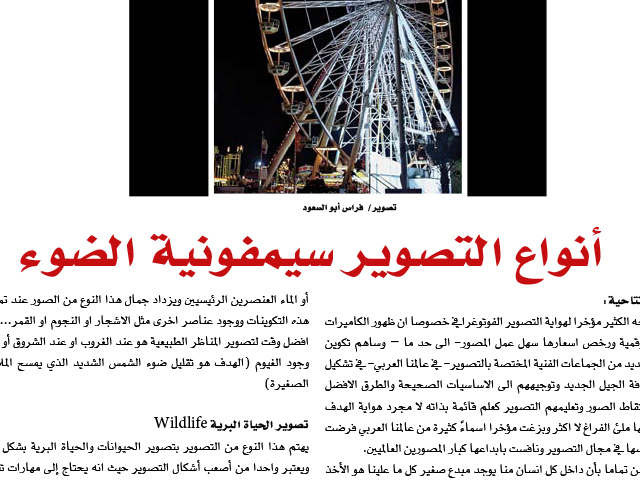This was a three-part article published on The Line magazine in Numbers 2, 3/4, the first of which was in April 2011.
Editorial:
Many have recently turned to the hobby of photography, especially since the emergence of digital cameras and their cheap prices facilitated the work of the photographer – to some extent – and contributed to the formation of many artistic groups specialized in photography – in the Arab world – in shaping the culture of the new generation and directing them to the right basics and the best ways to take pictures and teach them photography as a self-contained science not just a hobby aimed at filling the void no more and recently emerged many names from the Arab world imposed themselves in the field of photography and competed with the creativity of leading international photographers.
I fully believe that within each of us there is a small creator, all we have to do is take his hand to grow and develop his skills and then draw for himself a bright future in the field in which he saw himself and because of my love for the hobby of photography and given my great belief in the existence of many underlying talents that only need someone to hold her hand and encourage her to learn all that would discover that creator hiding inside it, I decided to prepare/collect a series of basic articles in the world of photography and hope to help every beginner who loves this hobby.

Landscape landscape photography
This type of area is considered the most commonly used, especially since most people like to document their trips with pictures, whether it is a professional camera or even cameras integrated into mobile devices. In this type of photography, the earth, sky or water are the main elements and the beauty of this type of image increases when these formations are combined and the presence of other elements such as trees, stars or the moon… etc. The best time to photograph the landscape is at sunset, at sunrise or when there are clouds (the goal is to reduce the extreme sunlight that wipes out the small features)
Photo by Rima Abdullah Al-Zayer
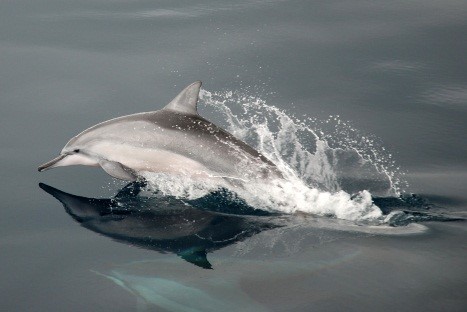
Wildlife Wildlife Photography
This type of photography is interested in animal and wildlife photography in general and is considered one of the most difficult forms of photography as it needs advanced technical skills, and the photographer must be aware of everything related to animals and their behavior in order to know the place and the best time to take pictures and predict the reactions of animals and thus get natural images. Many make mistakes when they include pictures of domestic animals or those in zoos for this type of photography as it is specialized only in those living in their natural environment.
Photo by Dr. Ali Omar Abu Al-Saud
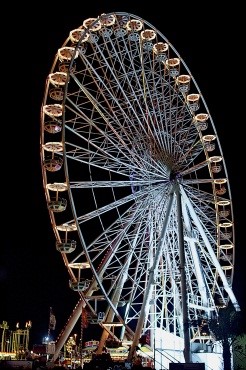
Night Shots:
As is clear from the name, this type specializes in images taken at night, where light is minimal and is relied on either industrial lights or long exposure to take clear and accurate images. The perfect time for this species is minutes after sunset or just before sunrise, when the sky is dark blue. It is important to have a tripod when shooting this type and the flash should not be used at all.
Photo by Firas Abu Al-Saud

Architecture Architecture:
This type of photography is concerned with architectural buildings and their beauty in artistic ways, including both indoor and external photography. Most of the purpose of this photography is either historical documentation or for advertising purposes. One of the most beautiful benefits of this genre is the introduction of different civilizations.
Photo by Abbas Thursday
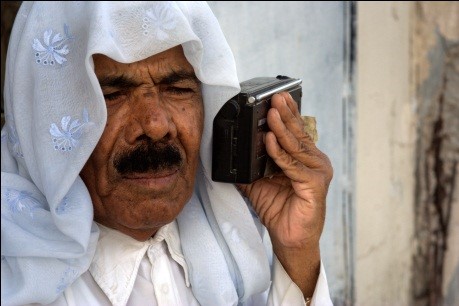
Daily Life:
It is clear to us the definition of this type of name, which is in short, the depiction of the manifestations of daily life around us from people walking around or working, as well as pictures of cafes, alleys and streets… Street Photography is included in this type. This type is considered to be the easiest type in terms of the possibility of working on it, but the specialist knows its difficulty, especially since it requires the presence of people who may not like the idea of being within the framework of the picture and also in the difficulty of identifying the subject.
The picture of the gentlemen’s ether

Photojournalism:
This type is the most commonly used among professional photographers where news agencies rely on them to obtain documentation of everything that happens on political or social arenas or natural accidents and this type requires courage, speed and high professionalism to shorten everything that happens in a form that brings the situation closer to those who see it.
Photo by Hussein Radwan
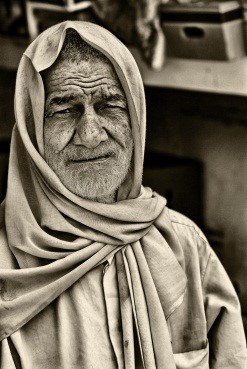
Portrait Facial Photography
This type competed first in terms of the number of lovers and the reason is known which is that we all like to document events and although most of what the majority do is photograph events in general and rarely focus on the features of a person itself which is preferred to work in this type of photography where the focus is often on the eye of the person as it is the source of the power of the image. The more the facial features and details are highlighted, the more beautiful the image, especially when photographing the elderly and showing the impact of the years on their faces. Of course, photographing a group of people is part of this type of photography. Most images in this type are usually documentary and are intended for special viewing, not public display.
Photo by Nayef Al-Daman lens

Still Life Photography
In this type, fixed objects that are arranged and driven in a certain way are photographed based on the skill and creativity of the photographer – or his assistant – and is frequently used in the filming of advertisements. This type of species that we see frequently in our Arabian Gulf is because photography is done inside an air-conditioned place and therefore does not affect the difficulty of the atmosphere outside and also its photography does not require going out with all the equipment to a place that may be far away and the results may not be as we expect. Most of the uses of this type are the field of product photography
The picture is in huda al-Rahan’s lens.

High Speed Photography
This type specializes in photographing moving objects at high speed and thus obtaining shots that the naked eye cannot realize its beauty and needs high techniques and special equipment that can cost a lot of money. Photographer Mohammed al-Momen believes that the name of fast object photography is inaccurate because the bodies depicted are not fast, but the event itself is rapid, so he suggested changing the title to “shooting fast events”. Examples of this type include the depiction of the break-up of the cup, the fall of water droplets or their impact on a surface, the explosion of a balloon, a bullet that cuts an apple… etc
Photo by Mohammed al-Momen

Macro Close-Up Photography
Close-up photography, also known as Close Up, is shooting things at close range and trying to show off their exact details. The name may seem strange especially for those who have knowledge of Greek as it means (large) but the name can be linked to the fact that the final image is for a enlarged part of the small thing. The most professional of this type of photography like to photograph insects and roses. The beauty of this type of photography is that it shows us things we can’t see with the naked eye.
The picture is in sadiq’s lens.

Abstract Abstract:
This type of photography is different from other types in that this type depends on the photographer’s imagination to create a distinctive painting of things that we may see on a daily basis and do not draw our attention. Abstraction has different ways, including the use of colors or patterns (repeating shapes) combined to create the image and many associate abstraction with ambiguity. To illustrate this genre, here are some examples that can be the subject of an abstract image: images of adjacent sand dunes – multiple tributaries of a building – a set of successive leaves – cracks in the land of Yabasa… etc
Photo by Zaki Diver

Sport Sports Photography
Sports photography is part of photography as it is a documentation of the event and requires speed and professionalism and needs special equipment, but here the sports photographer must be familiar with the sports play laws he portrays to increase the chances of getting distinctive shots.
The picture is in the lens of this tooth

Black and White:
This type is also known as monochrome photography. I hesitated a lot before the inclusion of this genre as an independent type because most of its topics are included in the previous types and it is just that the picture comes in black and white grades no more but after talking to some friends I thought that this topic could be an independent type and as the friend photographer Abbas said Thursday: “Because monochrome conversion is a self-contained art and since black and white is the main classical school in the past, Many professionals classify black-and-white photography as a stand-alone hub based on the conversion process and its inefficiency, and also because of the need to pay attention to contrast and other things, so you find that all black and white competitions or exhibitions are often open-ended because they are art in processing.” The International Federation of Monochrome Photography (Black and White) defines as follows: “Works ranging from very dark gray (black) to very bright gray (white), monochrome works in different shades of gray and black and white works that are perfectly consistent or (diluted) in one color remain monochrome and may be classified as black and white.”
Photo by Abdullah Abu Al-Saud

Silhouettes
Celluit is a type of art in general as the cellulite was used first in the art of painting and then expanded its fields until it reached the world of photography. A simplified siluit shoot is meant to depict imagination or shadow in the sense of showing the limits of the body without highlighting its features and details and showing us in black. This type was named “Seluit” in relation to a French minister named Etienne de silhouette, where he cut black paper shapes and glued them to white paper so that the result would be a beautifully contrasting painting.
Photo by Zuhair Tarifi Lens
In conclusion, there are other types other than those mentioned in this article, but what we have mentioned here are the most commonly used species and what remains is either that their uses are not common or are derived from one or more of the previous types, such as the filming of advertising products that are part of the depiction of static life or macro or both at the same time, as well as in the case of panoramas that may tolerate more than one type and we will have stops with some of these types in the coming numbers if God willing.
Reporting by Firas Abu Al-Saud
Sources:
http://www.seafriends.org.nz/phgraph
http://www.buzzle.com/articles/types-of-photography.html
http://www.answers.com/topic/architectural-photography
Note: Please do not use any of the images in the topic without reference to their owners as they allowed them to be used only within this topic
